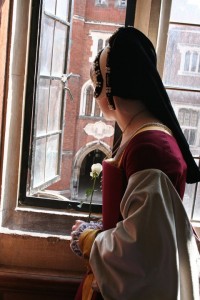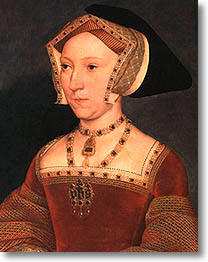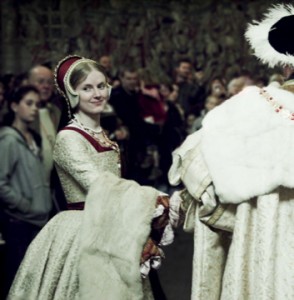An event over this Easter weekend (6th – 9th April, 2012) at Hampton Court Palace re-examines the brief queenship of Jane Seymour, and presents a far more politically active queen than many will be familiar with. Lauren Johnson, who interprets Jane, and is the Research Manager for Past Pleasures Ltd. shows here why ‘plain Jane’ deserves a second look.
Henry VIII and his six wives is a perennial topic for adaptation, whether into works of history, literature, for film or stage. The fact of a man marrying and disposing of, or outliving, so many women is intriguing in itself, but when coupled to the extraordinary personalities of those involved, it is easy to see why we keep returning to the Henrician age. What particularly interests is that after his first union with Catherine of Aragon, Henry broke the pattern of dynastic alliance of his predecessors, repeatedly marrying Englishwomen of little innate political importance, and out of genuine passion rather than dutiful affection. Henry VIII could be gullible when it came to marriage, as the veil drawn over Catherine Howard’s sexual experience showed, but he could not be forced into an affection he did not feel. The spectacular failure of his diplomatic marriage to Anne of Cleves is testament to that: he never consummated the marriage and it was annulled within six months of their first meeting. So there must have been something extraordinary about the women he fell in love with; each of them remarkable in their own way, certainly, whether because of outward charms (Howard), sexual wiles (Anne Boleyn, Howard again) or intelligence (Boleyn, Kateryn Parr), but all remarkable.
Jane Seymour is the one wife who consistently seems to defy Henry’s pattern. As David Starkey writes in his 2004 work Six Wives: The Queens of Henry VIII,
‘What was there here – a woman of no family, no beauty, no talent, and perhaps not much reputation – to attract a man who had already been married to two such extraordinary women as Catherine and Anne?’
Contemporary sources seem to support this. When he first heard of the King’s courtship of ‘Mistress Semel’, the Imperial ambassador Eustace Chapuys dwelt most upon the lady’s interest in Princess Mary’s future, and only vaguely noticed that she was ‘of middle stature and no great beauty’, ‘not a woman of great wit, but she may have good understanding’. Later, when greeting Jane as queen, Chapuys emphasized her pacific qualities, while the native courtier, Sir John Russell emphasized her gentleness. These feminine virtues of meek amiability are those most associated with Jane, and which she herself emphasized in her motto as queen: ‘Bound to obey and serve.’ Since she died within eighteen months of her marriage to Henry, giving him the healthy son he so desperately wanted, there was little opportunity to promote an alternative representation, and many historians have skimmed over Jane as little more than a transition between the bluff young Hal who broke with Rome out of hot-tempered passion, and the morbid creature who devoured three wives in his last seven years. Henry himself did much to enshrine the ‘cult of Jane’, with her image and iconography (the phoenix, the panther, the unicorn) living on long after his queen was dead.
Yet this saccharine image of feminine perfection is as misleading as it is simplistic. Jane was neither silent nor a cipher. She was politically motivated enough to push those issues in which she had a real interest – religious change, the status of the King’s eldest daughter, Mary – and astute enough to know when to back down. Indeed, her very silence on certain political matters was a choice designed to ensure she could not be attacked for the outspokenness that had tainted Anne Boleyn. Nonetheless, Jane was also not as secure in her position as her posthumous reputation would have us believe. Despite her coronation being planned, it never took place, and the King’s eye wandered during her reign just as it had under Catherine and Anne. The fact that her fundamental duty – getting pregnant – was not fulfilled for eight months also made her vulnerable.
The key to understanding Jane’s queenship, I suggest, is the manner of her ascent to the throne. The coup which replaced the outspoken Boleyn and the Howard faction with the Seymours and religious conservatives, was far from bloodless, and the men and woman executed at the Tower of London in the days before Henry VIII proposed to Jane were not strangers to her: Jane had served in the Queen’s household for years, and must have known the courtiers and musician who spent so much time there. Jane’s involvement with these events reveals a willingness to sacrifice others for her own advancement that seems far from the ‘pacificating’ of her queenship, and also gives some indication of why she pursued a policy of extravagant outward deference to her husband.
In her willingness to gain the throne over the corpse of her predecessor, Jane displayed asang froid comparable to that of her male counterparts at the highest level of the King’s Court. It is astonishing to the twenty-first century eye that colleagues who worked alongside each other in apparent harmony for years could suddenly not only acquiesce to, but actively play a part in, their associate’s death. The Duke of Norfolk presided over the treason trials of his nieces, the Bishop of Winchester sat on the Privy Council with Thomas Cromwell, but sent him to the executioner in 1540, Cromwell himself cooperated with the Marquess of Exeter to bring down Anne Boleyn, only to conspire in his downfall and death in 1538. It was a nobleman’s right to be tried by his peers, so inevitably, if accused of a crime he placed his fate in the hands of his colleagues. And this politicking extended beyond the Court too. During the trial of some of the leaders of the northern rebellion, the Pilgrimage of Grace in 1537, their own neighbours and kinsmen sat in judgment of the traitors.
Whatever her outward appearance of dutiful submission may have been, we know that Jane was not devoid of political interest, and we also know that she attempted to voice her opinions to her husband. What is noticeable, though, is that at every recorded instance of her attempt to do so, she was slapped down. Even before her marriage, Jane laid out her interest in the status of the King’s eldest daughter. She ‘suggested that the Princess should be replaced in her former position’. At a time when the princess’s marriage and position in the Succession were of keen international interest Jane followed her allies the Marchioness of Exeter and Sir Nicholas Carew in being vocally pro-Mary. She also quite skilfully handled the King’s rebuff to her suggestion that ‘she was a fool, and ought to solicit the advancement of the children they would have between them, and not any others. She replied that in asking for the restoration of the Princess she conceived she was seeking the rest and tranquillity of the King, herself, her future children, and the whole realm; for, without that, neither your Majesty nor this people would ever be content.’ Throughout the months when Mary held out against the King’s ministers and their demands that she announce her ‘bastard’ status, Jane continued to act as mediator between the King and his daughter. In this she followed a pattern of queenship long expected and respected, tempering the ruler’s intractability with appeals for mercy and peace. Yet even when acting within the prescribed template of queenship, Jane’s attempts at involvement were quashed and Henry ‘rudely repulsed’ her. When Chapuys drew her into a promise to assist Mary however she could, Henry briefly turned his back on conversation with court ladies to insist that Jane was not experienced in her dealings with ambassadors and cut the discussion off.
Jane’s control over her own image also revealed itself from the early days of the King’s courtship. Consistently, she sought to cultivate the image of herself as the ideal sixteenth century woman. When the King sent her a purse of money she refused it with melodramatic kneeling, weeping and letter-kissing for the benefit of the royal messenger, who of course relayed the story to his master. This show was designed to enflame the King’s ardour without compromising her honour, and on both counts she was successful. She was ‘most firm’ according to Chapuys that she would not be alone with Henry unless they were married, and the King accepted it. Whether Jane was advised by others to engage in his display or not, she carried it out, and she successfully won the King’s affection – and then kept it. Just like her predecessors, she had a fight on her hands to do so. Within a month of her wedding Chapuys was already reporting the King’s forlorn sighs towards two beautiful ladies, showing ‘himself somewhat sorry that he had not seen them before he was married’, and speculating on Jane’s replacement: ‘if… there is danger of her being barren, occasion may be found to take another (wife)’. Within her own household, where she had more autonomy, Jane was highly proscriptive. She controlled the clothing of her ladies in waiting, insisting on modest, high-fronted gowns and hair-concealing gable hoods rather than the French fashions of Anne’s Court. The subsidiary benefit that this would have rendered her attendants less obviously attractive to her husband was probably no coincidence. Jane’s careful choice of deferential royal motto and adaptation of her family’s peacock crest (a recognized image of pride) into the phoenix, a symbol of renewal and sacrifice, were also conscious efforts to produce the image of a submissive, pious and faithful wife.
Perhaps Jane’s most personally dangerous attempt at political intervention was her role in defending the religious conservatism exemplified by the rebels during the Pilgrimage of Grace. Jane, too, was conservative in her religious opinions, and did not support the suppression of the monasteries which the King was so fervently pushing forward. There are two different stories of Jane’s plea for the old ways in autumn 1536: in one report she was said to have thrown ‘herself on her knees before the King and begged him to restore the abbeys’. In another, slightly later version of events, she sailed dangerously close to censuring the King and suggested that ‘perhaps God permitted this rebellion for ruining so many churches’. Both versions of the story agree that the King’s response to her pleading was ‘reminding her that the last Queen had died in consequence of meddling too much with State affairs’, ‘which was enough to frighten a woman who is not very secure’.
It is interesting to compare these images of conjugal strife with the later images of Jane, where she is an idealized consort, much lamented and so well loved that the King chooses burial with her over any of his other wives. Realistically, of course, we could point out that he had few options left to him for a burial place – he had buried Catherine of Aragon against her wishes in Peterborough Abbey, Anne Boleyn and Catherine Howard lay in traitors’ graves in the Tower and his other two wives were still alive. The crucial change in the dynamic of Henry and Jane’s relationship came with her pregnancy in 1537. Had she survived the birth of Edward, and any future children, it seems very unlikely the King would have treated Jane as he had Catherine and Anne. At the time of Henry’s death in 1547 she would not yet have been 40, and with a minor for a king, is likely to have taken on an important role in government, maybe even become regent.
Over a century ago, Agnes Strickland’s Lives of the Queens of England from the Norman Conquest asserted that ‘the terror of the axe…(overshadowed) the brief term of (Jane’s) sceptred slavery.’ Given her known instances of attempted outspokenness, perhaps we should view Jane, not as the Queen who was the most submissive and ‘favourite’ of Henry’s wives, but as the wife who was most consistently silenced and overruled by her husband? And, crucially, the wife who was saved by the birth of a son.
This research was originally undertaken for Historic Royal Palaces on behalf of Past Pleasures Ltd., and is reproduced with their permission.
For more from Lauren see her blog.




















Wonderful article! I have always viewed Jane Seymour as politically aware and quite cunning young woman. The prospect of becoming the next Queen of England probably overcame her fears; I only wonder whether she knew that Anne Boleyn will be sent to the scaffold or she rather expected that the king will only divorce/annul his marriage to Anne? I think that Jane knew that not only Anne ‘has to go’ but also her supporters.
Great Reading here! Thanks for sharing :0) I agree, there was more to Jane than others give her credit for.
Great article. I’m currently reading ‘The Favored Queen’ by Carolly Erickson and this also gives me a different perspective about Jane Seymour. She probably knew what she was getting into when she became King Henry VIII’s wife and knew when to let the situation go (looking at what had happened to Anne Boleyn).